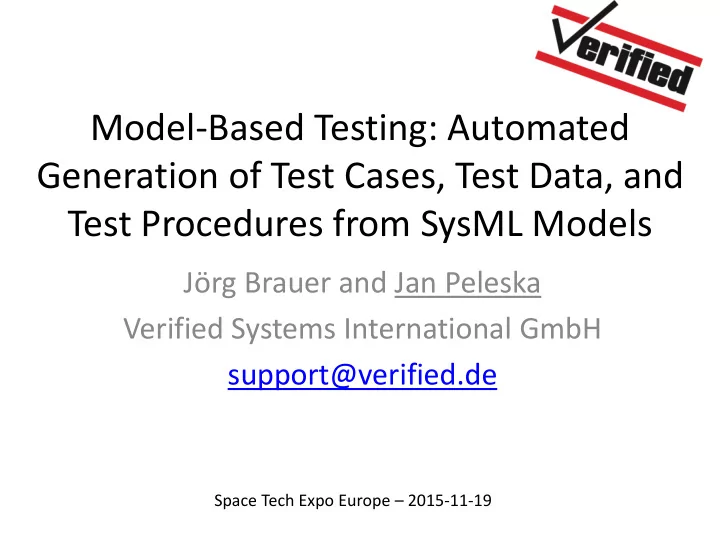

Model-Based Testing: Automated Generation of Test Cases, Test Data, and Test Procedures from SysML Models Jörg Brauer and Jan Peleska Verified Systems International GmbH support@verified.de Space Tech Expo Europe – 2015-11-19
Motivation • Model-driven system and software development has become an established best practice – at least in certain application fields • Model-based testing , however, is an active research area, but many enterprises are hesitant to adopt it as an integrated part of their V&V processes
Motivation • In this presentation, it is explained why – Model-based testing is fit for industrial application – The return of investment into test model development is significant, leading to • reduced V&V costs • increased test strength • simpler accumulation of certification evidence
Overview • Workflow – overview • Test model development • Model-based requirements tracing • Test procedure generation and execution • Conclusions
Overview • Workflow – overview • Test model development • Model-based requirements tracing • Test procedure generation and execution • Conclusions
MBT Workflow
Manual MBT Workflow activities
Fully automated MBT Workflow activities
Overview • Workflow – overview • Test model development • Model-based requirements tracing • Test procedure generation and execution • Conclusions
Test Model Development • The test model specifies – Interfaces between SUT and environment are represented as readable or writable in the test campaign – Structural aspects – functional decomposition – Behavioral aspects – transformation of inputs into outputs, sequencing, synchronisation ... • Two alternatives for test model creation and utilisation (see next slides)
Development Model vs. Test Model
Overview • Workflow – overview • Test model development • Model-based requirements tracing • Test procedure generation and execution • Conclusions
Model-Based Requirements Tracing • Objective – Link model elements to associated requirements that are represented by these elements – This allows us to identify test cases suitable for verifying a given requirement in an automated way • SysML is a system modeling language providing (graphical and textual) syntax for linking requirements to behavioral and structural model elements
Model-Based Requirements Tracing
Overview • Workflow – overview • Test model development • Model-based requirements tracing • Test procedure generation and execution • Conclusions
Test Procedure Generation and Execution • Test cases can be identified by evaluating the links between model elements and requirements • The behavior expressed by the model can be internally encoded by logical formulas • The test case is internally represented by a logical formula as well • → Concrete test data can be automatically calculated using mathematical constraint solvers
Test Procedure Generation and Execution • For test procedure generation, users just configure which test cases should be covered by the procedure to be created – Requirements-driven generation is performed by identifying the requirement (or a subset of related test cases) to be tested by the procedure – Model-driven generation is performed by identifying the model portions to be covered by the test procedure
Requirements-Driven Test Procedure Generation
Requirements-Driven Test Procedure Requirements are Generation displayed with their associated test cases, to be selected for test procedure generation
Model-Driven Test Procedure Generation
Model-Driven Test Procedure Model browser allows Generation to select elements to be covered by the test procedure
Test Procedure Generation and Execution • 6 Different testing strategies are supported – Simple: Basic control state coverage, Transition coverage, Hierarchic transition coverage. – Complex : • MC/DC coverage . Complex guard conditions are exercised with different valuations of their atomic condition parts • Basic control state pairs coverage . Interacting state machine pairs are tested in every possible state combination • Equivalence class testing strategy . Inputs with large data types are automatically partitioned into equivalence classes
Test Procedure Generation and Execution • Applicable strategies can be automatically adapted to the criticality of SUT component under consideration – For DAL-C components, transition coverage typically suffices – For DAL-A components, the more complex strategies have to be applied as well
Overview • Workflow – overview • Test model development • Model-based requirements tracing • Test procedure generation and execution • Conclusions
Conclusions • Model-based testing is fit for large-scale application in industry • Efficiency measurements performed by Verified Systems show that the following effort reductions in comparison to conventional testing approaches can be expected – 30% for a new project, where a new test model has to be created – 90% in the best case, where an optimised re-usable workflow has been set up for regular regression testing of a long-lived product
Recommend
More recommend